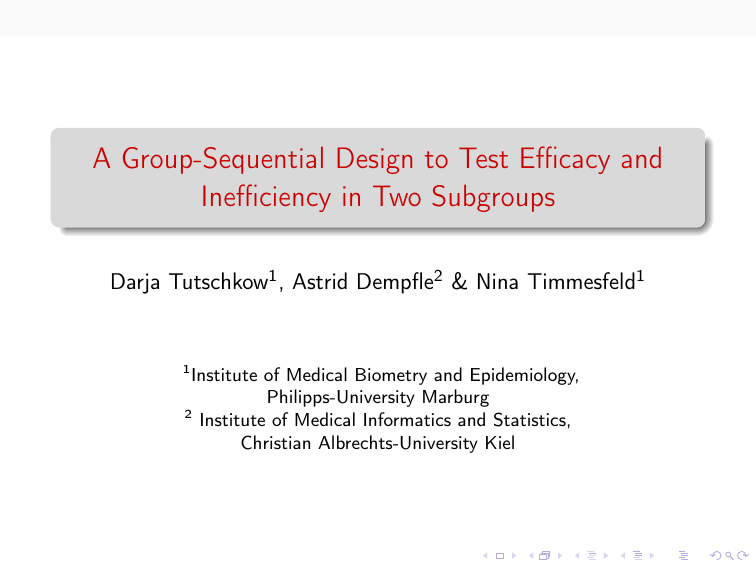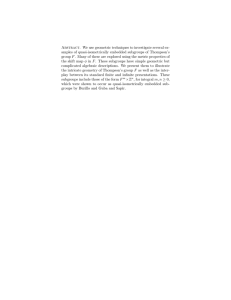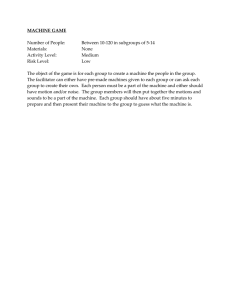A Group-Sequential Design to Test Efficacy and Inefficiency in Two
advertisement

A Group-Sequential Design to Test Efficacy and
Inefficiency in Two Subgroups
Darja Tutschkow1 , Astrid Dempfle2 & Nina Timmesfeld1
1
Institute of Medical Biometry and Epidemiology,
Philipps-University Marburg
2
Institute of Medical Informatics and Statistics,
Christian Albrechts-University Kiel
Motivation
Group-sequential Design for Both Subgroups
Example: two analyses
Contents
1
Motivation
2
Group-sequential Design for Both Subgroups
3
Example: two analyses
4
Summary and Outlook
Summary and Outlook
Motivation
Group-sequential Design for Both Subgroups
Example: two analyses
Summary and Outlook
Motivation
stratified medicine → tailored therapies for patient subgroups
based on biomarkers
predictive biomarkers → effect of a therapy depends on
biomarker status
biomarkers identified as predictive in retrospective or
exploratory analyses
’issue of multiplicity’ → risk of false positive findings
biomarker-negative subgroup (M − ) not included in later
phase III trail → no statistically confirmed evidence of
inefficiency in M −
Motivation
Group-sequential Design for Both Subgroups
Example: two analyses
Summary and Outlook
Motivation
stratified medicine → tailored therapies for patient subgroups
based on biomarkers
predictive biomarkers → effect of a therapy depends on
biomarker status
biomarkers identified as predictive in retrospective or
exploratory analyses
’issue of multiplicity’ → risk of false positive findings
biomarker-negative subgroup (M − ) not included in later
phase III trail → no statistically confirmed evidence of
inefficiency in M −
Motivation
Group-sequential Design for Both Subgroups
Example: two analyses
Summary and Outlook
Motivation
stratified medicine → tailored therapies for patient subgroups
based on biomarkers
predictive biomarkers → effect of a therapy depends on
biomarker status
biomarkers identified as predictive in retrospective or
exploratory analyses
’issue of multiplicity’ → risk of false positive findings
biomarker-negative subgroup (M − ) not included in later
phase III trail → no statistically confirmed evidence of
inefficiency in M −
Motivation
Group-sequential Design for Both Subgroups
Example: two analyses
Summary and Outlook
Motivation
stratified medicine → tailored therapies for patient subgroups
based on biomarkers
predictive biomarkers → effect of a therapy depends on
biomarker status
biomarkers identified as predictive in retrospective or
exploratory analyses
’issue of multiplicity’ → risk of false positive findings
biomarker-negative subgroup (M − ) not included in later
phase III trail → no statistically confirmed evidence of
inefficiency in M −
Motivation
Group-sequential Design for Both Subgroups
Example: two analyses
Summary and Outlook
Motivation
stratified medicine → tailored therapies for patient subgroups
based on biomarkers
predictive biomarkers → effect of a therapy depends on
biomarker status
biomarkers identified as predictive in retrospective or
exploratory analyses
’issue of multiplicity’ → risk of false positive findings
biomarker-negative subgroup (M − ) not included in later
phase III trail → no statistically confirmed evidence of
inefficiency in M −
Motivation
Group-sequential Design for Both Subgroups
Example: two analyses
Summary and Outlook
Example
trial where the benefit for the M − was overlooked
study led by the National Surgical Adjuvant Breast and Bowel
Project and the North Central Cancer Treatment Group
(Romond et al., 2005)
effect of Trastuzumab for HER2-positive breast cancer patients
only HER2-positive patients were included in the trial
some of initially HER2-positve patients, appeared to be
HER2-negative
subsequently tested HER2-negative patients
„benefit of adjuvant Trastuzumab may not be limited to
patients with HER2 amplification“ (Paik, Kim & Wolmark,
2008)
Motivation
Group-sequential Design for Both Subgroups
Example: two analyses
Summary and Outlook
Example
trial where the benefit for the M − was overlooked
study led by the National Surgical Adjuvant Breast and Bowel
Project and the North Central Cancer Treatment Group
(Romond et al., 2005)
effect of Trastuzumab for HER2-positive breast cancer patients
only HER2-positive patients were included in the trial
some of initially HER2-positve patients, appeared to be
HER2-negative
subsequently tested HER2-negative patients
„benefit of adjuvant Trastuzumab may not be limited to
patients with HER2 amplification“ (Paik, Kim & Wolmark,
2008)
Motivation
Group-sequential Design for Both Subgroups
Example: two analyses
Summary and Outlook
Example
trial where the benefit for the M − was overlooked
study led by the National Surgical Adjuvant Breast and Bowel
Project and the North Central Cancer Treatment Group
(Romond et al., 2005)
effect of Trastuzumab for HER2-positive breast cancer patients
only HER2-positive patients were included in the trial
some of initially HER2-positve patients, appeared to be
HER2-negative
subsequently tested HER2-negative patients
„benefit of adjuvant Trastuzumab may not be limited to
patients with HER2 amplification“ (Paik, Kim & Wolmark,
2008)
Motivation
Group-sequential Design for Both Subgroups
Example: two analyses
Summary and Outlook
Example
trial where the benefit for the M − was overlooked
study led by the National Surgical Adjuvant Breast and Bowel
Project and the North Central Cancer Treatment Group
(Romond et al., 2005)
effect of Trastuzumab for HER2-positive breast cancer patients
only HER2-positive patients were included in the trial
some of initially HER2-positve patients, appeared to be
HER2-negative
subsequently tested HER2-negative patients
„benefit of adjuvant Trastuzumab may not be limited to
patients with HER2 amplification“ (Paik, Kim & Wolmark,
2008)
Motivation
Group-sequential Design for Both Subgroups
Example: two analyses
Summary and Outlook
Example
trial where the benefit for the M − was overlooked
study led by the National Surgical Adjuvant Breast and Bowel
Project and the North Central Cancer Treatment Group
(Romond et al., 2005)
effect of Trastuzumab for HER2-positive breast cancer patients
only HER2-positive patients were included in the trial
some of initially HER2-positve patients, appeared to be
HER2-negative
subsequently tested HER2-negative patients
„benefit of adjuvant Trastuzumab may not be limited to
patients with HER2 amplification“ (Paik, Kim & Wolmark,
2008)
Motivation
Group-sequential Design for Both Subgroups
Example: two analyses
Summary and Outlook
Example
trial where the benefit for the M − was overlooked
study led by the National Surgical Adjuvant Breast and Bowel
Project and the North Central Cancer Treatment Group
(Romond et al., 2005)
effect of Trastuzumab for HER2-positive breast cancer patients
only HER2-positive patients were included in the trial
some of initially HER2-positve patients, appeared to be
HER2-negative
subsequently tested HER2-negative patients
„benefit of adjuvant Trastuzumab may not be limited to
patients with HER2 amplification“ (Paik, Kim & Wolmark,
2008)
Motivation
Group-sequential Design for Both Subgroups
Example: two analyses
Summary and Outlook
Example
trial where the benefit for the M − was overlooked
study led by the National Surgical Adjuvant Breast and Bowel
Project and the North Central Cancer Treatment Group
(Romond et al., 2005)
effect of Trastuzumab for HER2-positive breast cancer patients
only HER2-positive patients were included in the trial
some of initially HER2-positve patients, appeared to be
HER2-negative
subsequently tested HER2-negative patients
„benefit of adjuvant Trastuzumab may not be limited to
patients with HER2 amplification“ (Paik, Kim & Wolmark,
2008)
Motivation
Group-sequential Design for Both Subgroups
Example: two analyses
Summary and Outlook
Motivation
stratified medicine → tailored therapies for patient subgroups
based on biomarkers
predictive biomarkers → effect of a therapy depends on
biomarker status
biomarkers identified as predictive in retrospective or
exploratory analyses
’issue of multiplicity’ → risk of false positive findings
biomarker-negative subgroup (M − ) not included in later
phase III trail → no statistically confirmed evidence of
inefficiency in M −
study design to test for superiority or inefficiency of a new
therapy in both subgroups
Motivation
Group-sequential Design for Both Subgroups
Example: two analyses
Summary and Outlook
Motivation
stratified medicine → tailored therapies for patient subgroups
based on biomarkers
predictive biomarkers → effect of a therapy depends on
biomarker status
biomarkers identified as predictive in retrospective or
exploratory analyses
’issue of multiplicity’ → risk of false positive findings
biomarker-negative subgroup (M − ) not included in later
phase III trail → no statistically confirmed evidence of
inefficiency in M −
study design to test for superiority or inefficiency of a new
therapy in both subgroups
Motivation
Group-sequential Design for Both Subgroups
Example: two analyses
Summary and Outlook
Group-sequential Design for Both Subgroups
1
2
j
j
Assumptions: XAi
∼ N (µjA , σ 2 ) iid, XBi
∼ N (µjB , σ 2 ) iid
with known σ 2 and j ∈ {+, −}
Hypotheses:
H0j,S : δ j ≤ 0 vs. H1j,S : δ j > 0 (Superiority)
H0j,I : δ j ≥ ∆ vs. H1j,I : δ j < ∆ (Inefficiency)
3
where δ j := µA − µB (difference in treatment effects in
subgroup M j ) and ∆ > 0 (inefficiency margin)
Restrictions:
1
2
predefined number of interim analyses
equal amount of patients in each subgroup for each interim
analysis
Motivation
Group-sequential Design for Both Subgroups
Example: two analyses
Summary and Outlook
Group-sequential Design for Both Subgroups
1
2
j
j
Assumptions: XAi
∼ N (µjA , σ 2 ) iid, XBi
∼ N (µjB , σ 2 ) iid
with known σ 2 and j ∈ {+, −}
Hypotheses:
H0j,S : δ j ≤ 0 vs. H1j,S : δ j > 0 (Superiority)
H0j,I : δ j ≥ ∆ vs. H1j,I : δ j < ∆ (Inefficiency)
3
where δ j := µA − µB (difference in treatment effects in
subgroup M j ) and ∆ > 0 (inefficiency margin)
Restrictions:
1
2
predefined number of interim analyses
equal amount of patients in each subgroup for each interim
analysis
Motivation
Group-sequential Design for Both Subgroups
Example: two analyses
Summary and Outlook
Group-sequential Design for Both Subgroups
1
2
j
j
Assumptions: XAi
∼ N (µjA , σ 2 ) iid, XBi
∼ N (µjB , σ 2 ) iid
with known σ 2 and j ∈ {+, −}
Hypotheses:
H0j,S : δ j ≤ 0 vs. H1j,S : δ j > 0 (Superiority)
H0j,I : δ j ≥ ∆ vs. H1j,I : δ j < ∆ (Inefficiency)
3
where δ j := µA − µB (difference in treatment effects in
subgroup M j ) and ∆ > 0 (inefficiency margin)
Restrictions:
1
2
predefined number of interim analyses
equal amount of patients in each subgroup for each interim
analysis
Motivation
Group-sequential Design for Both Subgroups
Example: two analyses
Summary and Outlook
Hierarchical Testing
first intermin analysis:
testing superiority in M + and inefficiency in M −
if one of either hypotheses is rejected, test it in the other
subgroup
following interim analyses:
testing superiority in M + and inefficiency in M − as long as no
hypothesis is rejected
testing both hypothesis in a subgroup if a hypothesis got
rejected in the other subgroup
Motivation
Group-sequential Design for Both Subgroups
Example: two analyses
Summary and Outlook
Hierarchical Testing
first intermin analysis:
testing superiority in M + and inefficiency in M −
if one of either hypotheses is rejected, test it in the other
subgroup
following interim analyses:
testing superiority in M + and inefficiency in M − as long as no
hypothesis is rejected
testing both hypothesis in a subgroup if a hypothesis got
rejected in the other subgroup
Motivation
Group-sequential Design for Both Subgroups
Example: two analyses
Hierarchical Testing - Example
k=1
k=2
M+
M−
H0+,S
H0−,I
Summary and Outlook
Motivation
Group-sequential Design for Both Subgroups
Example: two analyses
Summary and Outlook
Hierarchical Testing - Example
k=1
k=2
continue
M+
M−
H0+,S
H0−,I
reject
reject
continue
Motivation
Group-sequential Design for Both Subgroups
Example: two analyses
Hierarchical Testing - Example
k=1
k=2
M+
M−
H0+,S
H0−,I
reject
reject
stop
Summary and Outlook
Motivation
Group-sequential Design for Both Subgroups
Example: two analyses
Hierarchical Testing - Example
k=1
M+
M−
H0+,S
H0−,I
reject
continue
stop
H0+,I
k=2
Summary and Outlook
Motivation
Group-sequential Design for Both Subgroups
Example: two analyses
Summary and Outlook
Hierarchical Testing - Example
k=1
M+
M−
H0+,S
H0−,I
reject
continue
stop
H0−,S
k=2
Motivation
Group-sequential Design for Both Subgroups
Example: two analyses
Summary and Outlook
Hierarchical Testing - Example
k=1
M+
M−
H0+,S
H0−,I
reject
continue
stop
reject
stop
k=2
H0−,S
Motivation
Group-sequential Design for Both Subgroups
Example: two analyses
Summary and Outlook
Hierarchical Testing - Example
k=1
M+
M−
H0+,S
H0−,I
reject
continue
stop
H0−,S
continue
k=2
H0−,S
H0−,I
Motivation
Group-sequential Design for Both Subgroups
Example: two analyses
Summary and Outlook
Hierarchical Testing - Example
k=1
M+
M−
H0+,S
H0−,I
reject
continue
continue
stop
H0+,I
reject
continue
k=2
reject
H0+,S
H0+,I
reject
stop
H0−,S
continue
H0−,S
H0−,I
Motivation
Group-sequential Design for Both Subgroups
Example: two analyses
Summary and Outlook
Hierarchical Testing - Example
k=1
k=2
continue
H0+,S
M+
M−
H0+,S
H0−,I
continue
H0−,I
Motivation
Group-sequential Design for Both Subgroups
Example: two analyses
Summary and Outlook
Hierarchical Testing - Example
k=1
k=2
M+
M−
H0+,S
H0−,I
continue
H0+,S
continue
reject
H0−,S
continue
H0−,I
Motivation
Group-sequential Design for Both Subgroups
Example: two analyses
Summary and Outlook
Simulation
rejection probabilities for different treatment effects in both
subgroups
expected sample size in both subgroups
computing the number of required patients N + and N − in M +
and M − respectively, such that decision at the last analysis
→ N + = N − = 2 · 72
FWER 5 %
K=2 analyses
10.000 repetitions
∆ = 0.5
σ2 = 1
Motivation
Group-sequential Design for Both Subgroups
Example: two analyses
Summary and Outlook
Results
δ+
0
0
0
∆
∆
2∆
2∆
δ−
∆
2∆
0
∆
0
0
2∆
H0+,S
0.025
0.025
0.024
0.986
0.979
1
1
H0+,I
0.024
0
0.963
0
0.021
0
0
H0−,I
0.025
0
0.984
0.025
0.980
0.977
0
H0−,S
0.024
0.025
0
0.962
0.020
0.023
1
E(N + )
142
143
100
88
88
72
72
E(N − )
142
143
88
100
88
87
72
H0j,S : δ j ≤ 0 vs. H1j,S : δ j > 0 (Superiority)
H0j,I : δ j ≥ ∆ vs. H1j,I : δ j < ∆ (Inefficiency); ∆ = 0, 5
Motivation
Group-sequential Design for Both Subgroups
Example: two analyses
Summary and Outlook
Results
δ+
0
0
0
∆
∆
2∆
2∆
δ−
∆
2∆
0
∆
0
0
2∆
H0+,S
0.025
0.025
0.024
0.986
0.979
1
1
H0+,I
0.024
0
0.963
0
0.021
0
0
H0−,I
0.025
0
0.984
0.025
0.980
0.977
0
H0−,S
0.024
0.025
0
0.962
0.020
0.023
1
E(N + )
142
143
100
88
88
72
72
E(N − )
142
143
88
100
88
87
72
H0j,S : δ j ≤ 0 vs. H1j,S : δ j > 0 (Superiority)
H0j,I : δ j ≥ ∆ vs. H1j,I : δ j < ∆ (Inefficiency); ∆ = 0, 5
Motivation
Group-sequential Design for Both Subgroups
Example: two analyses
Summary and Outlook
Results
δ+
0
0
0
∆
∆
2∆
2∆
δ−
∆
2∆
0
∆
0
0
2∆
H0+,S
0.025
0.025
0.024
0.986
0.979
1
1
H0+,I
0.024
0
0.963
0
0.021
0
0
H0−,I
0.025
0
0.984
0.025
0.980
0.977
0
H0−,S
0.024
0.025
0
0.962
0.020
0.023
1
E(N + )
142
143
100
88
88
72
72
E(N − )
142
143
88
100
88
87
72
H0j,S : δ j ≤ 0 vs. H1j,S : δ j > 0 (Superiority)
H0j,I : δ j ≥ ∆ vs. H1j,I : δ j < ∆ (Inefficiency); ∆ = 0, 5
Motivation
Group-sequential Design for Both Subgroups
Example: two analyses
Summary and Outlook
Summary and Outlook
group-sequantial design to test for superiority and inefficiency
for both subgroups for normally distributed data
next steps:
1
2
account for different group sizes
extension for survival data
at some point: add more flexibility, e.g.
start with the full set, switch to hierarchical procedure and the
other way around
increase or reduce number of interim analyses
change test statistic or outcome measure during the course of
the trail, etc. → CRP-method (Müller & Schäfer)
Motivation
Group-sequential Design for Both Subgroups
Example: two analyses
Summary and Outlook
Summary and Outlook
group-sequantial design to test for superiority and inefficiency
for both subgroups for normally distributed data
next steps:
1
2
account for different group sizes
extension for survival data
at some point: add more flexibility, e.g.
start with the full set, switch to hierarchical procedure and the
other way around
increase or reduce number of interim analyses
change test statistic or outcome measure during the course of
the trail, etc. → CRP-method (Müller & Schäfer)
Motivation
Group-sequential Design for Both Subgroups
Example: two analyses
Summary and Outlook
Summary and Outlook
group-sequantial design to test for superiority and inefficiency
for both subgroups for normally distributed data
next steps:
1
2
account for different group sizes
extension for survival data
at some point: add more flexibility, e.g.
start with the full set, switch to hierarchical procedure and the
other way around
increase or reduce number of interim analyses
change test statistic or outcome measure during the course of
the trail, etc. → CRP-method (Müller & Schäfer)
Motivation
Group-sequential Design for Both Subgroups
Example: two analyses
Thank you for your attention! Questions?
Summary and Outlook
Motivation
Group-sequential Design for Both Subgroups
Example: two analyses
Thank you for your attention! Questions?
Summary and Outlook

